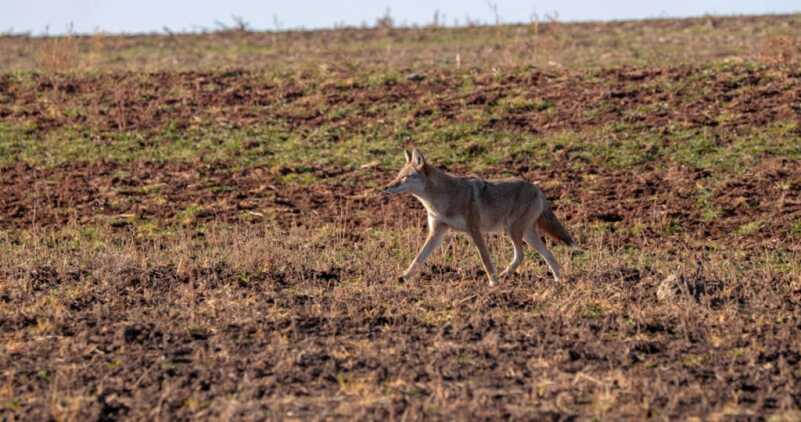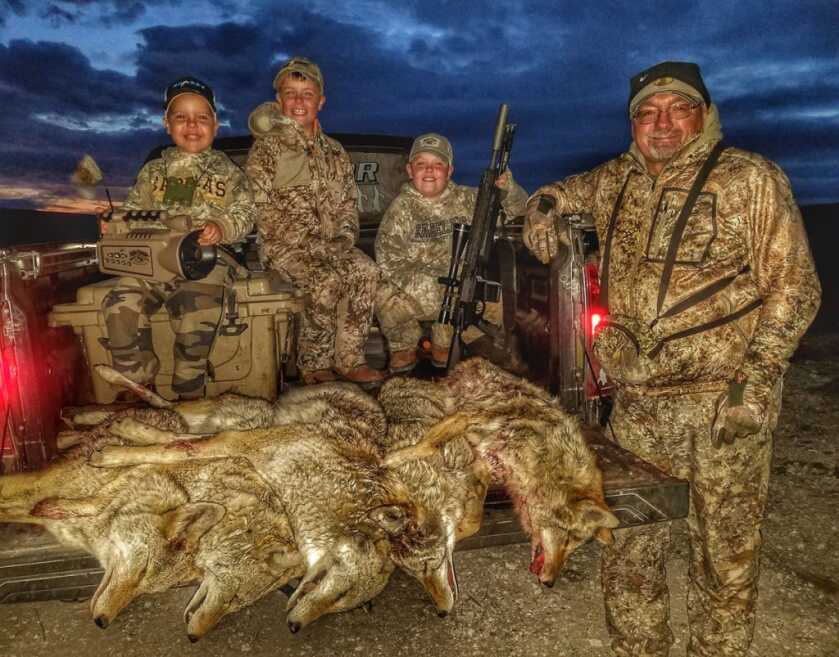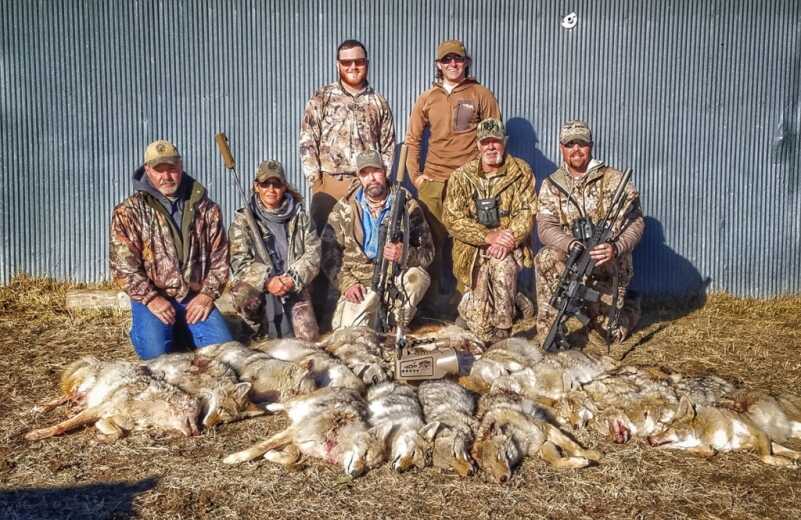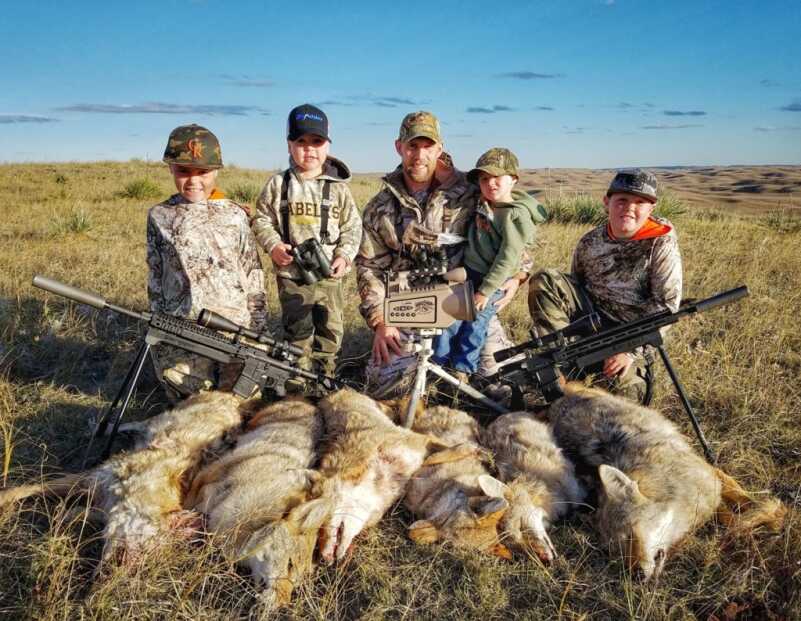With spring fever running rampant throughout the outdoor community, it’s easy to get caught up in the hoopla of open water and thundering toms. But for those who didn’t get their fill of coyote hunting this winter, spring can provide some fantastic opportunities with some added benefits. Throughout this article, I’ll discuss the ecological benefit of hunting coyotes in the springtime as well as effective strategies for calling coyotes this time of year.
The Benefit
People hunt coyotes for a variety of reasons. It may be to help hone their hunting skills, it may be for the fur money, it may be a way for them to fill the void in between big game seasons and the spring turkey opener, or it may be a way for them to manage the predator populations in an area. If predator management is a priority, spring is the time to step up your game. In order to illustrate this, we must look at the dynamic of the coyote population in relation to the localized pressure coyotes put on fawns, calves and other food sources.
When looking at the coyote dynamic, you’ll find basically 2 types of coyotes. First is the territorial coyote. These coyotes have established an area of their own and are normally the older, more dominant coyotes. These coyotes will make up a large percentage of the breeding population and may share their territory with a mate and pups for a certain portion of the year. Territorial coyotes will generally remain in that established area until they are killed off or run off by a more dominant coyote. Second is the transient coyote. These coyotes are nomads that roam around looking for areas that have been recently vacated by territorial coyotes. Once a transient coyote finds an area and establishes dominance, they become a territorial coyote. Transients are normally the younger, less aggressive coyotes in the population. These coyotes will generally not breed due to their age and in some cases will represent more than half of the coyote population in an area.

“Transient coyotes are constantly on the move and make up a majority of the overall coyote population.” PC – Dreamweaver Creative
The most vulnerable time for depredation of fawns, calves and other young animals is within the first few weeks of their lives. If there is a high density of coyotes in these areas during this timeframe, it’s not uncommon to experience high mortality rates. In some cases, fawn mortality due to coyote depredation has exceeded 70% in some case studies. Providing relief for this brief period in the spring is key. Predator control in an area is temporary, and only impactful in the area it was conducted. If you consider the 2 types of coyotes mentioned above, you’ll understand why that is. When coyotes are killed out of a certain area, there’s a good chance those coyotes were of the territorial type. Depending on the density of transient coyotes in the surrounding areas, new coyotes will move into that area within several weeks and establish dominance. From a predator control standpoint, once this happens you’re right back to where you started. For example, you have a 1500 acre deer lease and you’re seeing a lot of coyotes on the property. You decide that the coyotes need to be thinned out so that your fawn recruitment on the site will be as high as possible. When deer season is over you kill off a handful of coyotes through the months of December and January but don’t continue the control measures past that. During the months of February, March and April new coyotes move in and fill in the holes, putting the coyote densities back to their original numbers before you started the predator control measures. Once the deer start fawning, the carrying capacity for coyotes in the area is back to being full and higher fawn mortality should be expected. If predator control measures are implemented through the months of April and May, the coyote population does not have time to fill in the holes you’ve created and recruitment of fawns will be higher.
Strategies
Hunting pressure on coyotes generally peaks in January. Coyotes that are constantly being pressured become stressed and extremely cautious. These stressed and cautious coyotes become call-shy and seem to be virtually un-callable in most situations. Hence, coyote hunting in late winter can be a challenge. But once February passes, the pressure starts dropping considerably. After 4-6 weeks of little to no hunting pressure, coyotes begin reverting back to their normal routines. In many ways, calling coyotes during the late spring months can be similar to early fall. The overall coyote densities are not nearly as high but the way coyotes react to the call and the sounds used to make that happen are the same.
For those looking for a recipe playlist, stick to using primarily prey and pup distress sounds. As mentioned earlier, coyotes have ample opportunities to fill their bellies with young, unsuspecting prey during the late spring months. Starting stands off using a higher-pitched prey distress sound like a cottontail rabbit or bird will generally do the trick. If nothing responds within the first 6 minutes, transition over to pup distress. Let that sound play for another 6 minutes. If you’re running a Lucky Duck Predator Call, sounds like BB Cottontail Demise, Luckypecker, Schoolyard Brawl, Pup Chaos and Pup Detention are great options to use in your recipe.
A second strategy for spring is to specifically target territorial coyotes that have a den site. These coyotes will generally be the most vocal and aggressive this time of year. The key to this strategy is locating the coyotes and then moving in as close as you can before you start to call. Locating can be done ahead of time during an evening trip through your calling area or a run-and-gun approach can be used during the hunt. If you elect to locate ahead of time, evening hours are preferred. Coyotes will generally be the most vocal at night and light winds will normally allow you to hear responding coyotes from greater distances. Depending on the area you are locating in, stopping every 2 miles to let out a few howls from your ecall is ideal. Sit quietly at that spot for 5 minutes and listen for any coyotes that respond. Specifically, take note of multiple coyotes responding from the same area. More than likely these are the dominant coyotes you will want to target. If these coyotes have a den site, they will normally not travel very far from that area on a daily basis and when you come back a few days later, they should be within an earshot of your setup.
If you’re using a run-and-gun approach and hunting as you locate, making an educated guess as to how far away the responding coyotes are is crucial. The goal is to set up within 600 yards of the howling coyotes without them knowing you are there. The closer you get to the unsuspecting coyotes, the better the odds will be of you calling them in. Whether you’re locating ahead of time and targeting those areas at a later date or locating and hunting at the same time, the sound sequence recipe is the same once you move in and set up. The goal is to trigger the aggression in those coyotes by playing coyote-based sounds like howls and fights. Start the sequence off with a few lone howls or a pair howl scattered across the first 2-3 minutes of the stand. After sitting quietly for a few minutes, transition into a coyote fight for 5 minutes. If the coyotes howl back but never show up, sit quietly for 10 minutes. Then sneak in further, cutting the distance in half and then repeat the sound sequence.
Springtime coyote hunting can be exciting and beneficial for those willing to pass up an occasional day on the lake or in the turkey woods. Predator management during this time of year is crucial for fawn recruitment and for those looking to boost herd numbers for the following season. Implementing the strategies above will increase your odds of bagging April coyotes and help save a few fawns along the way!





Hunting Coyotes to the extent shown here is Bull Shit.
A Coyote hunter is just a step away from shooting Dairy Cows. This type of “Sport” is what makes people believe all hunting is Wrong. It is difficult to find anything positive about Hunting Coyotes for Sport. I have a true disdain for ANYONE who thinks this is a Sport.
I bet anyone who professes to be a Coyote Hunter ;in the “off season,” goes to Greenland to Club Seal Pups. Has a couple of Domestic Violence charges, and 3-4 restraining orders as well.
God Bless.
Coyotes have killed all the turkeys that used to be on my hunting property. They are an invasive species in my part of the country, and the local fauna have no experience with them.
Hunting coyotes? What sort of lowlife does that. Feed coyotes to your family, do you? Why not shoot the neighbor’s dogs while you’re at it.
Feed coyotes to the family? You bet! Check out this recipe: https://staging-digest-ovh.gunsamerica.com/hunt365-coyote-its-whats-for-dinner/
You are a dip wad with out a clue !!!! Kill em all and there will be more next year!!!!
Not the sharpest tool in the shed, are we James?
James
If you catch a mouse in a trap do you feed it to your family?
I agree with the hunting of Coyotes to maintain a balance in the population. But we need to remember that they are here to help control the deer and other populations.
There are far to many deer in the wild today as a result of killing off of nature population balancing animals. Every animal has its place in Gods plan so please keep thins in mind when trying to kill of a natural predator that has been put on this earth to balance nature.
Not to provide sport for some of us.
Not just for sport but for food also: https://staging-digest-ovh.gunsamerica.com/hunt365-coyote-its-whats-for-dinner/
I Hunt and Trap Coyotes and I Got 53 This Last Trapping Season, But if You Keep on Telling Every one that You are Hunting them When They Have Pups in Their Den Then Get Ready for The Antis to Come After Your Hunts, Even I Give Them a Break When They Have Pups In Their Dens, Besides They are Not Worth Any Thing This Time of The Year.
I fully agree with Randy. In this day and age we need a bit of discretion and thought while editing the article so we don’t have to do so much damage control (dealing with death threats over facebook posts, etc). It’s all about public perception. Put yourself in your enemies’ shoes, and counter their arguments before they even happen.
It’s not just hunters. Even mom and pop agriculture is compared to burying your dead at night these days.
Antis will be antis. Regardless of when you hunt your game. I enjoy spring predator hunting. While I understand your passion for them and respect your decision to “give them a break”, To me they are like rats or mice. And I let the crows and magpies eat em!